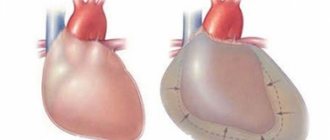Mydriasis is the dilation of the pupil. The pupil reacts to the level of illumination by dilating (if there is not enough light) or narrowing (in bright light) - this is a physiological process. Pupils can react by increasing their size not only to external, but also to internal changes, for example, they dilate when a person experiences stress. After dilation, the pupil returns to normal. But mydriasis can also be pathological, when subsequent narrowing does not occur, in which case it acts as a symptom of the disease.
With mydriasis, the pupil enlarges to 7-10 mm
Causes
Physiological dilation of the pupil occurs in low light and when looking into the distance. When a person experiences severe stress, under the influence of the sympathetic nervous system, mydriasis occurs, the eyes (pupils) dilate - the saying “fear has big eyes” is about this. This reaction is normal and its purpose is to improve vision.
Physiological mydriasis is always temporary, it lasts as long as the action of the stimulus lasts, and when the conditions change (fear passes, the light turns on), the pupils return to normal.
Physiological pupil dilation is caused by the following factors:
- lack of lighting;
- emotional arousal (both positive and negative);
- great surprise; increased attention to something;
- looking into the distance;
- reaction to surprise, for example, a sharp loud sound;
- deep breath.
Mydriasis can be medicinal or drug-induced. In this case, he is called specifically so that the ophthalmologist can conduct an examination of the fundus or perform surgical intervention. Dilation of the pupils is achieved by instillation (dropping) into the eye of a drug that causes temporary paralysis of the sphincter of the pupil - the circular muscle that constricts the pupil. Such drugs include Midriacil, Irifrin, Tropicamide. Atropine has a similar effect, but is used less frequently, since its effect lasts much longer, up to two weeks, which can lead to significant inconvenience for the patient. Sometimes drug mydriasis can be a side effect of therapy, for example, when treating a spasm of accommodation.
There are many causes of pathological mydriasis, including:
- intoxication with chemicals, carbon monoxide;
- overdose (intoxication) with certain medications (Atropine, Scopolamine, Platiphylline, Ephedrine);
- drug use (hallucinogens, cocaine, ecstasy, methamphytamines, cannabis);
- diseases of the central nervous system (brain tumors, dislocation syndrome, stroke);
- fractures of the base of the skull or orbit;
- spinal cord injuries;
- eyeball injury;
- acute oxygen deficiency;
- aneurysm of the posterior communicating artery;
- near-death state, coma;
- preeclampsia (complication of pregnancy);
- congenital pathologies (hydrocephalus);
- ophthalmological diseases (glaucoma, myopia, iridoplegia, inflammation of the optic nerve, iridocyclitis, Bumke syndrome, Pourfure du Petit syndrome, blindness of various etiologies, paralysis of the ciliary muscle);
- infectious diseases (tuberculosis, neurosyphilis, botulism, diphtheria, viral infections);
- pathologies of the nervous system (Adi syndrome, epilepsy, Parkinson's disease, sympathicotonia, encephalopathy, migraine, cranial nerve neuropathies);
- systemic diseases (multiple sclerosis);
- diseases of internal organs (kidney and liver failure, heart and lung diseases, some pathologies of the digestive system);
- metabolic disorders (thyroid pathologies, diabetes mellitus).
Classification
The condition falls into two main categories:
- physiological, which occurs during normal activity of the body, for adaptation of the organs of vision;
- pathological, formed when disorders and diseases occur.
In turn, the pathological condition is divided into the following categories:
- medicinal – exposure to drugs that change the state of the brain or organs of vision;
- traumatic – resulting from mechanical damage;
- spastic – occurring as a result of an increase in hormones or stimulation of nerve endings, which causes spasm of the pupillary dilator;
- paralytic - formed when there are disorders in the oculomotor nerve, which leads to paralysis of the sphincter of the pupil;
- arbitrary - occurs extremely rarely, is formed by the will of the person himself.
The condition is divided into several types according to the degree of impact on the eyeballs:
- unilateral – development of the condition in only 1 eye;
- bilateral – development of the condition in both eyes.
The main difference between a physiological and a pathological condition is the reaction of the pupil to exposure to bright light. If mydriasis is physiological, it will narrow; if it is pathological, there will be no reaction.
Forms
Physiological, medicinal, and pathological mydriasis were described above. In addition, it can be unilateral or bilateral, asymmetrical or symmetrical, transient or permanent.
According to the mechanism of development, the following types of mydriasis are distinguished;
| Type | Characteristic |
| Physiological | Always bilateral, symmetrical and temporary. |
| Medication | Iatrogenic in origin, does not pose a danger, stops after the effect of the drug. |
| Paralytic | Caused by paralysis of the pupillary sphincter. It can occur when the oculomotor nerve is damaged, usually caused by pathologies of the central nervous system (neurosyphilis, epilepsy, Parkinson's disease, hydrocephalus, etc.). |
| Spastic | Caused by a spasm of the dilator pupillary muscle (the muscle that dilates the pupil), which occurs in response to irritation of the cervical sympathetic trunk, it can also be a consequence of severe intoxication or disease of the internal organs. With this type of mydriasis, the reaction to light and distance remains. |
| Traumatic | May be caused, among other things, by surgical trauma. Postoperative mydriasis can persist for years, in which case iris surgery is performed to eliminate it. |
| Adi syndrome | Its cause is damage to the ciliary ganglion in a number of diseases. Pupil dilation is unilateral. Recovery is long, sometimes taking several years. |
A distinctive feature of modern human life is hypokinesia. Reduced muscle loads and prolonged forced positioning of the body and head lead to muscle detraining, weakening of their spring function, and increased load on the intervertebral discs, joints and ligaments. Diseases of the central nervous system of a vertebrogenic nature are currently second only to acute respiratory diseases in prevalence among the population. Spinal diseases occur in 60-90% of the population over 50 years of age. The number of young people suffering from this pathology is constantly increasing [9, 25, 30].
A normally functioning spine is a natural kinematic chain consisting of seven individual vertebrae articulated with each other by intervertebral discs, paired true joints and ligaments. The occurrence of ocular symptoms is facilitated by the anatomical features of the cervical region. This is the most mobile and most vulnerable part of the spine; normally it describes a regular arch with a forward convexity - lordosis. The two upper (rotational) vertebrae are significantly different from the remaining (flexor) vertebrae.
The first cervical vertebra - the atlas - is connected to the occipital bone by two joints and supports the skull. The second cervical vertebra has an odontoid process directed upward, with the atlas “strung” on it. Thanks to this unpaired joint between the atlas and the tooth of the second vertebra, the head turns to the sides. The remaining 5 cervical vertebrae are connected to each other by discs and processes. The muscular system also plays a huge role in ensuring the motor function of this part of the spine [10, 11, 20, 24, 44, 47, 48].
All cervical vertebrae (except VII) have openings in the transverse processes through which the vertebral arteries and accompanying veins and nerves pass. A.a. vertebralis
, being the first branch of the subclavian arteries, form the main artery. It constitutes the vertebrobasilar system that supplies the occipital lobes with the central link of the visual analyzer, the brain stem, the nuclei and conductors of the oculomotor, trochlear, abducens nerves and the system of the posterior longitudinal fasciculus, the fibers of which ensure the joint and simultaneous work of the oculomotor muscles [35, 37, 43 ].
The sympathetic nerve trunk extends from the base of the skull to the neck of the first rib, located behind the carotid arteries on the deep muscles of the neck. These are three sympathetic ganglia: the upper cervical, middle cervical and lower - cervicothoracic (stellate ganglion). The internal carotid nerve n. departs from the superior cervical ganglion . caroticus internus
, the lower cervical ganglion gives off the vertebral nerve
n.
vertebralis . These nerves accompany the arteries of the same name, forming plexuses around them, ascending into the cranial cavity, where they anastomose with each other and give branches to the vessels of the brain. From the branches of the sympathetic plexus of the carotid artery and the upper cervical ganglion, vasoconstrictors go to the glands of the head, including the lacrimal gland [8, 13, 24, 33, 36, 46].
Pupil dilatation center (Budge center, or centrum ciliospinale
) is located in the anterior horns of the spinal cord at the level from the 8th cervical to the 2nd thoracic segment.
Innervation of the muscle that dilates the pupil is provided by n.
sympaticus .
The anterior roots of these parts of the spinal cord pass through all three cervical sympathetic ganglia. In the ganglion cervicale,
the preganglionic neuron ends and a new postganglionic neuron begins, which reaches the plexus of the internal carotid artery [1, 3, 21, 42].
Sympathetic fibers enter the orbit in the form of the periarterial plexus of the ophthalmic artery, give off a root to the ciliary ganglion and, as part of short ciliary nerves, reach the eyeball. The cervical sympathetic nerves are connected to the smooth muscles of the orbit, narrow the lumen of the ophthalmic arterioles and dilate the pupil. The peripheral section of the parasympathetic pupillomotor pathway extends from the nucleus n. ocolomotorius
to the sphincter [1, 19, 41, 43].
The openings in the transverse processes of the cervical vertebrae are quite narrow, the neurovascular bundle is closely adjacent to the bone walls. Therefore, when you rotate your head, strain your neck muscles, or organic changes in the spine, neurovascular formations can be subject to trauma and deformation. The slightest displacement of the cervical vertebra causes a reflex spasm of the vertebral artery, which subsequently causes compression. Local (cervical sympathetic nodes and fibers) and general (by the type of reflex involvement of hypothalamic autonomic centers) autonomic formations are involved in the process. Pathological afferentation that occurs in the area of the vertebral nerve, through a large number of anastomoses, can spread to the periarterial plexuses of the carotid and ophthalmic arteries, which leads to pain in the orbit, eyeballs, and decreased blood circulation in the organ of vision [8, 10, 13, 22, 32 ].
The relationship between changes in the cervical region and some eye pathologies has been established during experimental and clinical studies. In 1866, a printed work by Prof. E.V. Adamyuk “On the influence of the sympathetic nerve on intraocular pressure”, in which glaucoma was considered as a secretory neurosis caused by irritation of the cervical sympathetic nodes [1].
When studying the regulatory role of the central nervous system and individual nerves affecting the eye, Soviet scientists obtained a lot of valuable data. In the 20s of the last century V.P. Roshchin confirmed the role of the sympathetic nervous system in the origin of glaucoma [17]. Further experimental studies conducted by L.S. Levina (1941), A.B. Desyatnikov (1953), I.F. Sinitsin (1971) showed that irritation or extirpation of the superior cervical sympathetic ganglion leads to fluctuations in intraocular pressure [2]. I.B. Kaplan and A.T. Gudneva (1980) in 32% of patients with intraocular pressure of 27-33 mm Hg, by treating the cervical spine, they achieved its reduction to normal levels [30]. A.M. Grinstein (1957), G.N. Grigoriev (1969), as well as D.I. Antonov (1970) pointed out the sometimes occurring attacks of unilateral loss of the visual field or part of it, combined with spasm of the retinal artery when the cervical sympathetic structures are damaged [2].
In the middle of the last century, works devoted to the clinic of visual disturbances in occlusions of the intra- and extracranial sections of the vertebral arteries also appeared in foreign literature: Synonds, Mackenzie (1957), Hoyt (1959), Minoretal (1959), Kearns (1960). Visual disorders have been associated with ischemia of the occipital lobe cortex, especially their poles and areas adjacent to the calcarine sulcus [2, 40].
The dependence of visual disturbances on the condition of the spine is indicated by changes in the fundus of the eye that appear after exposure to the muscles and ligaments of the cervical spine. During the Bertschi stretch or during neck extension, some subjects observed changes in the fundus: dilation of large veins, narrowing of arterial trunks, or dilation of arteries with unchanged vein diameter [30].
G.P. Smolyakova et al. (1988) found that when the superior cervical sympathetic nodes are irritated, changes characteristic of age-related macular degeneration appear. E.S. Abdulaeva (2002) recorded changes in blood flow in the siphon of the internal carotid and vertebral arteries in patients with non-exudative forms of macular degeneration [14].
Swiss ophthalmologist Johann Friedrich Horner in 1869 described anterior cervical sympathetic syndrome as changes in the face on the side where there is insufficiency of sympathetic innervation caused by a pathological process in the neck or chest. In France and Italy, the name of physiologist Claude Bernard is also associated with this pathology [1, 39].
Bernard-Horner syndrome can be congenital, acquired, or iatrogenic. The reasons for the development of such a symptom complex are numerous: surgical manipulations on the sympathetic nodes, tumor and inflammatory processes of the cervical spine, spinal cord, upper segments of the chest, syringomyelia, multiple sclerosis. Cases of the appearance of Horner's syndrome in individuals weakened after acute infections, herpetic diseases, and scleroderma have been described; with improvement in general condition, anterior cervical sympathetic syndrome completely disappeared in these patients [1, 21, 27].
The Bernard-Horner triad is a set of symptoms: ptosis, miosis, enophthalmos. Miosis is formed due to the shutdown of m. dilatator pupillae
, a narrow palpebral fissure is associated with sympathetic ptosis, switching off the Müller muscle, and enophthalmos is a consequence of switching off the Landström orbital muscle. Of the three main symptoms, miosis and ptosis are always the most prominent [1].
Horner's syndrome is often complicated by a number of other painful conditions: hypotension, discoloration of the iris, cataracts, lacrimation, dilation of the conjunctival and retinal vessels. Sometimes all this is accompanied by sweating and hyperemia of the skin of the corresponding half of the face [1, 22]. In children, the lack of sympathetic innervation prevents the pigmentation of melanocytes located in the stroma of the iris, so Horner's syndrome can lead to heterochromia [1, 38].
With anterior cervical sympathetic syndrome, pupillary reactions to light and reactions to near installation proceed in the same way as normal, or may even be somewhat more vibrant, but to a lesser extent. The return to the initial state occurs more slowly [1, 18, 42].
The painful pupillary reaction, in contrast to the light reaction and the reaction to near installation, in Horner's syndrome decreases significantly, becoming noticeable only with strong painful stimulation [1, 8].
Drooping of the upper eyelid may also be associated with damage to n. oculomotorius
. In such cases, insufficient innervation of the sphincter causes pupil dilation. In real clinical work, such ptosis is quite easy to distinguish. In addition to mydriasis, when the oculomotor nerve is damaged, ptosis is more pronounced and can completely close the entire eye [1, 40, 42].
Posterior cervical sympathetic syndrome was described by the French neurologist J. Barre in 1925, later supplemented in more detail by the Chinese physician J. Lieo in 1928. Synonyms of the Bare-Lieu symptom complex are: vertebral artery syndrome, cervical migraine, spinal nerve syndrome, sympathetic vertebral nerve neuritis [5, 11, 15, 32].
The disease occurs if compression of the vertebral artery or its sympathetic plexus occurs due to osteochondrosis, trauma or tumor in the neck. But the first place in the pathogenesis of the development of vertebral artery syndrome belongs to the growth of the uncinate processes in the direction of the intervertebral foramina and the narrowing of the latter. Another reason is lesions and changes in the vertebral arteries themselves: occlusion, deformation, anomalies of origin, location and entry. Posterior cervical sympathetic syndrome leads to various manifestations of vertebrobasilar insufficiency. There are functional and organic stages [2, 9, 15, 16, 45].
The functional stage of vertebral artery syndrome is characterized by three groups of symptoms: headache, cochleovestibular and visual disorders [5, 19, 21, 23].
In most patients, pain, starting in the cervico-occipital region, spreads anteriorly to the mastoid-temporal, parietal and frontal regions with irradiation into the eye, accompanied by vestibular (dizziness, loss of balance), auditory (hearing loss and tinnitus), autonomic (sweating , feeling of heat, hot flashes, chills) disorders. Laryngeal and pharyngeal symptoms (dysphonia, dysphagia, pharyngeal paresthesia) may occur [5, 7, 12, 25, 27].
Painful sensations appear as a result of irritation of pain sensitivity receptors in the fibrous and muscular tissues of the spine, in the capsule of the intervertebral joints, ligaments, and tendons of the neck muscles. Palpation often reveals pain in the area of paravertebral points, spinous processes, and along the vessels of the cervical region. When palpating the muscles, one can find Cornelius and Müller's nodes, pain and tension in the anterior scalene muscle. Pain can spread to the shoulder girdle and chest, and radiate to the heart [5, 8, 10, 12, 44].
Visual disturbances were included by J. Barre (1926) in the description of posterior cervical sympathetic syndrome as an obligate symptom. Upon careful questioning, they are detected in almost all patients with vertebrobasilar insufficiency of any etiology. Ophthalmological symptoms of vertebral artery syndrome are described somewhat differently by different authors. In this work we have attempted to summarize the descriptions found in various literature sources. Ocular symptoms can be transient or persistent [5, 7, 25, 27].
Transient include photopsia. Patients complain of the appearance before their eyes of “black flies”, “soot”, “sparks”, “lightning”, multi-colored and golden dots that seem to flicker and oscillate. Photopsia in cases of cerebral circulatory disorders are point-like, their occurrence is not related to the light source, they continue even with the eyes closed [2, 12, 28, 29].
More complex photopsia may also appear, for example in the form of “white shiny rings”, often shiny zigzag lines, in the form of a moving stream of multi-colored (red, yellow and green) cubes. In all cases, visual disturbances are short-term and last only a few seconds [2, 11, 13, 21].
Blurred vision of objects, a feeling of “veil” or “fog” before the eyes is noted, according to the literature, in approximately half of patients with vertebral artery syndrome. With posterior cervical sympathetic syndrome, visual disturbances appearing along with pain in the cervical-occipital region are described: flickering scotomas, fog and darkening before the eyes, photophobia, lacrimation, a feeling of sand behind the eyelids, nystagmus, changes in pressure in the retinal arteries or the tone of the fundus vessels. Sometimes there is redness of the conjunctiva and the development of neurodystrophic keratitis [1, 5, 29, 31].
Such patients turn to an ophthalmologist with complaints of discomfort in the eyes, especially when working at close range for a long time. There may be a feeling of “fullness” in the eye socket, “twisting” of the eyeballs, which intensifies with strained vision, while reading, or eye movements. Patients with posterior cervical sympathetic syndrome may tell their ophthalmologist that they are experiencing double vision. The examination reveals a decrease in acuity and a narrowing of the visual field [6, 13, 30, 31, 34].
In patients with diseases of the cervical spine, blurred vision and blurred images are often aggravated by a sudden change in head position. At the same time, the general condition may worsen: headache, dizziness, and increased blood pressure may appear or worsen [4, 6, 7, 11, 35, 45, 48].
Sometimes eye symptoms and dizziness are provoked by throwing the head back, and in some cases they appear after excessive physical or emotional stress. They also often occur against a background of fatigue: during prolonged walking over rough terrain, physical work, situations involving holding one's breath, or develop after fainting. At the end of such an attack, vision can be completely restored [6, 13, 30, 31, 34].
With vertebrobasilar insufficiency, short-term disturbances of higher cortical functions are possible, such as various types of visual agnosia with impaired optical-spatial perception. They appear as a result of ischemia in the distal cortical branches of the posterior cerebral artery [2, 4, 7].
The appearance of bilaterally intermittent symptoms: darkening of the eyes, narrowing of visual fields, dysarthria, dysphagia or dizziness - confirms the presence of vertebrobasilar insufficiency. A person may lose vision for a few minutes or report short-term loss of peripheral vision due to dizziness. In such a situation, vomiting and instability when walking may occur [4, 6, 10, 12, 22].
The organic stage is characterized by transient and persistent circulatory disorders in the brain and spinal cord. In this case, visual symptoms include: decreased vision, double vision, ptosis. The eyeballs may be completely motionless or make floating movements, strabismus and anisocoria appear. In hemorrhagic stroke, unilateral mydriasis is determined on the side of the hemorrhage, along with the abduction of the eyes towards the lesion - “the patient looks at the paralyzed limbs” [4, 6, 8-10, 12, 22].
Vertebrogenic pathological conditions are a problem that is addressed by neurologists, orthopedists, neurosurgeons, etc. The close connection between the pathology of the brain and the eye is due to the anatomical and functional unity of their blood circulation. Therefore, situations are possible when ocular symptoms become one of the earliest cerebral manifestations of a disease of the cervical spine. Ocular changes may occur long before the development of other symptoms of vertebrobasilar insufficiency [4, 7, 13].
In cases where patients do not associate the pathology of the organ of vision with an uncomfortable posture during sleep or at the workplace, turning and tilting the head, it seems to them that it arises as if “by itself”, and it is to this that the ophthalmologist directs his main attention, while the root cause of the disease may go unnoticed [4, 7, 11, 13, 26, 42].
In conclusion, the authors of the article express the hope that the presented material will assist practicing ophthalmologists in making the correct diagnosis, prescribing adequate examination and treatment.
Signs
The main sign of mydriasis is the dilation of the pupil to 7-10 mm (normally its diameter is from 2 to 5 mm). If subsequent contraction of the pupil does not occur, this condition is accompanied by visual and general symptoms.
Visual symptoms:
- increased photosensitivity, intolerance to bright light;
- lack of reaction to light;
- lack of reaction to an object approaching the eye;
- decreased visual acuity;
- burning, pain in the eye (or both eyes, if mydriasis is bilateral);
- rapid eye fatigue;
- lacrimation;
- disturbance of eye movement in one or more planes;
- discomfort, pain when reading, watching TV, working at the computer.
With prolonged mydriasis, the following may appear:
- deformation of the pupil, it takes on a pear-shaped, teardrop-shaped or sharply oval shape (slightly oval pupils may be normal);
- ptosis (drooping eyelid);
- strabismus.
Deformation of the pupil in mydriasis
General symptoms accompanying pathological dilation of the pupils:
- headache;
- dizziness;
- sleep disorders;
- emotional instability, anxiety.
Mydriasis, caused by a certain disease, is accompanied by symptoms characteristic of this disease.
In children, pathology manifests itself in the same way as in adults.
Diagnostics
Mydriasis itself does not require special diagnostic methods, as it is detected visually. However, a thorough examination is necessary to identify its cause, without which treatment is impossible.
Primary diagnosis consists of collecting anamnesis, identifying associated symptoms, events preceding mydriasis, as well as an ophthalmological examination with mandatory ophthalmoscopy.
The patient is prescribed laboratory tests:
- clinical (general) blood test;
- clinical urine analysis;
- blood chemistry;
- blood test for hormones, primarily thyroid hormones.
Instrumental diagnostics include:
- CT (computed tomography) and/or MRI (magnetic resonance imaging) of the head;
- Ultrasound (ultrasound examination) of the abdominal organs;
- ECG (electrocardiography);
- chest x-ray.
Further diagnosis depends on what is found from the examination results. Depending on the nature of the identified pathology, consultation with related specialists may be necessary: neurologist, neurosurgeon, endocrinologist, traumatologist, etc.
Diagnosis of eye mydriasis
The first thing the ophthalmologist is convinced of is that pupil dilation is not physiological. Further examinations include:
- checking the visual organs using an ophthalmoscope;
- CT or MRI of the brain;
- neurosonography;
- Ultrasound of cerebral vessels;
- lumbar puncture;
- general blood and urine analysis, etc.
If the problem is not only ophthalmological, but also neurological, the patient must be sent to see a neurologist.
Treatment
Physiological and drug-induced mydriasis do not require treatment; in this case, the dilation of the pupils goes away on its own after the action of the etiological factor ceases.
Pathological mydriasis is not an independent disease, but a symptom of some pathology, therefore etiotropic treatment consists of measures aimed at the underlying disease.
Drug therapy
To eliminate mydriasis, in some cases, the use of drugs that weaken the effect of the dilator and stimulate the pupillary sphincter may be indicated. For this purpose, drugs of the following groups can be prescribed:
- alpha-blockers (Tropafen, Prazosin, Phentolamine);
- M-cholinomimetics (Pilocarpine, Aceclidine);
- N-cholinomimetics (Cititon, Lobelin).
Pilocarpine is a drug that in some cases is used to eliminate mydriasis
Depending on the underlying disease, the following may also be prescribed:
- diuretics;
- nootropic drugs;
- antiplatelet agents; and etc.
General recommendations
In case of pathological dilation of the pupils, the following restrictions must be observed:
- Avoid too bright lighting, exposure to open sun;
- Wear dark glasses outside;
- Refuse to drive a car during treatment, read long texts, or work at the computer.
- Stop smoking, drinking alcohol and taking psychoactive substances.
- Avoid self-medication and drug abuse. Take any medications only as prescribed by a doctor, strictly following the prescribed dosage.
Surgery
Surgical treatment is indicated in cases where the causative disease requires it, mainly:
- brain tumors or cysts;
- hematomas or abscesses of the brain;
- aneurysm of the posterior communicating artery.
Diagnosis and treatment of mydriasis
Short-term dilation of the pupils does not require treatment, but persistent mydriasis can be a symptom of serious diseases, so consulting a doctor is essential.
The main thing in eliminating mydriasis is treating the underlying disease that caused this symptom. Most often, the attending physician prescribes to the Patient drugs that enhance the work of the pupillary sphincter and weaken the function of the dilator.
As a rule, in this condition the Patient is worried about photophobia (sensitivity to light), so you should avoid bright lighting and wear sunglasses.
If you suspect mydriasis, you can contact Dr. Belikova’s Eye Clinic. We employ only experienced ophthalmologists and use only high-quality modern equipment. We will conduct a full examination of the visual organs to identify the causes of dilated pupils and select the most suitable treatment for you, based on the characteristics of your body.
Prevention
To prevent mydriasis, it is recommended:
- Refusal of drinking alcohol, psychoactive substances, smoking.
- Use of any medications as prescribed by a doctor in compliance with the prescribed dosage.
- Avoiding eye injuries (protection with special glasses at work, etc.) and head.
- Early detection and treatment of diseases that can lead to pathological dilation of the pupils.
- Undertaking preventive examinations with an ophthalmologist, if there are unpleasant symptoms associated with the eyes, immediately contact a specialist.
Main causes of mydriasis
- eye injuries (mostly blunt, non-penetrating, which do not lead to serious impairment, but cause eye contusion);
- damage and compression of the oculomotor nerves;
- traumatic brain injury with damage to nerve endings;
- neoplasms in the head;
- hypoxia;
- barbiturate poisoning;
- infectious diseases that affect intracranial and ocular nerve nodes.
Sometimes mydriasis is one of the symptoms of diabetes.
Dilated pupils can be induced artificially using eye drops. Ophthalmologists resort to this when examining the organs of vision, as well as before performing a number of eye surgeries. In other cases, it is necessary to establish the causes and stop the symptom itself.










